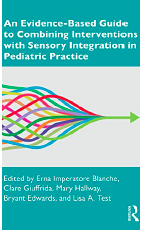An evidence-based guide to combining interventions with sensory integration in pediatric practice: A book review

An evidence-based guide to combining interventions with sensory integration in pediatric practice: A book review
by: Gustavo Reinoso, Ph.D., OTR/L and Thomas J. Decker, Ed.D. OTD, OTR/L
Because of the complexity of the clients we assess and treat utilizing sensory integration, we often wonder about how we can best address a family’s needs by incorporating other approaches during our busy practices. The concept of combining and blending approaches is not new. In 1995, Blanche, Botticelli and Hallway published a textbook “Combining Neuro-Developmental Treatment and Sensory Integration principles: An Approach to Pediatric Practice.” The textbook was well-received among clinicians
in the US and abroad. For the first time, a framework for examining different approaches, their philosophical bases, commonalities and discrepancies was presented for ‘clinical practice’. The emphasis on clinical practice is not trivial. More than ever before, clinicians prefer resources that can educate them, but also provide flexibility for quick applications in the ever-changing contexts in which we operate. In this regard, this textbook provided a clear path for implementation for children birth to 12. It included observat
ions, applications for children with various diagnoses, and drawings of activities clinicians can easily replicate in most outpatient pediatric clinics. This occupational therapy practice book provides multiple resources for repeated use by clinicians with varying experience, particularly when dealing with children that need a bit more than just sensory integration.
Many of us have been waiting for a revision of this textbook. Why? Perhaps the simplest answer is because we see children and families that require more than just one app
roach. We all know that we need to keep up-to-date while paying careful attention to emerging evidence. However, nothing prepared us for how much we all needed to alter our clinical practice. We all tried at least a bit of telehealth, personal protective gear, and/or treated children in at least one new context because of COVID-19. So, there is a renewed sense of excitement with the new textbook “An Evidence-Based Guide to Combining Interventions with Sensory Integration in Pedi
atric Practice,” which was just released by Routledge, the Taylor & Francis Group. The book was edited by Drs. Erna Imperatore Blanche, Clare Giuffrida, Mary Hallway, Bryant Edwards, and Lisa Test. It has over 30 contributors from different states, clinical practice settings, and countries.
The book contains 3 parts and 15 chapters in a 328 page medium sized book. The 3 parts center the argument around conceptual models that organize and ground sensory processing and sensory integration in practice. Clinical reasoning, service delivery, and the
changes that have occurred during COVID-19 are discussed in tandem with the International Classification of Function Disability and Health: Children and Youth version (SCF-CY) by the World Health
Organization (WHO, 2007). Both a conceptual model, the Reasoning in Action Model (RAM), and a Conceptual Sensory Processing Model are presented. These models are the organizing force and structure for the information presented in Parts 2 and 3.
Part 2 grounds theory and applications with perhaps the most common diagnoses we encounter today in pediatric clinical practice (i) autism spectrum disorders, (ii) cerebral palsy, (iii) developmental coordination disorder and other motor challenges, and lastly (iv) children under three years of age. The perspective of this section focuses on how information collected from different sources can be fed into a model to assist clinicians in generating hypotheses, linking them to specific issues to blend the best evidence with different approaches into an intervention plan. Thus, clinicians are guided through tables with potential hypotheses, pertinent clinical reasoning, interpretations/triggers, intervention targets, and potential solutions.
Part 3 has 8 chapters that delve into different pediatric intervention approaches and perspectives, and how they can be blended with sensory integration. One chapter discusses the impact of nature, natural environments, and elements of nature when they are incorporated into environmental designs and by exemplifying how occupational therapists are treating children in natural environments. Three other chapters discuss new developments and how sensory integration is being successfully blended with school-based practices to support participation and self-determination (e.g. push in, pull out, tier 1, consultation, etc.), how sensory processing is implemented in hospital settings, or with a particular emphasis on pediatric mental health. For example, the consideration of how the sensory properties of an oral hygiene program, or how sensory hyper-responsivity may need to be discerned from general anxiety are examples of how different authors present information from their current practices.

Additional chapters in Part 3 address feeding and eating issues in children with neurodevelopmental disorders, the context of play, the STAR frame of reference, as well as 5 descriptions of community-based programs that incorporate ingredients of sensory processing and integration. The chapter on feeding and eating provides several resources for data collection in addition to direct intervention. For example, the discussion of the Eating Sensory, Neuromotor, Anatomical Scale for Children (E-SNACK) provides a way for clinicians to organize evaluation data and determine priorities for intervention. The context of play elaborates on the complexity of this often poorly understood construct as well as some key research findings. The updates on the STAR frame of reference expands the concepts of sensory integration, processing, regulation and relationships.
The book finalizes with a rich description of five community programs: The Stepin’ Up Transition Group Program for High School Students with Developmental Disabilities in High-Risk areas, the Therapy West Integrated Specialized Program (TWISPP), The Moving to Make Friends© Program, The Kid Power Programs: A clinical Program to Enhance Spontaneous Use and Achieve Functional Goals, and finally, the Blue Bird Day Program. These programs expand our vision of how different principles of sensory processing and sensory integration are blended with other approaches such as the Model of Human Occupation (MOHO), Mindfulness, Developmental Individualized-differences and relationship based model (DIR), Social Participation, Bimanual Intensive Therapy, and parental education, among many others.
References:
Blanche, E. I., Giuffrida, C., Hallway, M., Edwards, B., &
Test, L. A. (2022). An evidence-based guide to com
bining interventions with sensory integration in pedi
atric practice (1st ed.). Routledge.
World Health Organization. (2007). International clas
sification of functioning, disability and health:
children and youth version: ICF-CY.
https://apps.who.int/iris/handle/10665/43737
